EMA at ICOLSE
Come see our talks at ICOLSE 2015 in Toulouse, France! All three talks will be presented on September 9th. See below for details.
Lightning Direct Effects on Anisotropic Materials from Electro-Thermal Simulation will be presented by Bryon Neufeld on Sept. 9 at 15:20 in the Cassiopée presentation room. Here’s the abstract:
Mitigating lightning Direct Effects (DE) damage on aerospace vehicles is an important engineering challenge and is directly related to safety of flight. Depending on the threat level and materials involved, vehicle surfaces and other design features may need to be protected to help mitigate damage. Numerical simulation can provide insight into the amount of damage likely to occur during a lightning strike and can reduce the costs associated with an expensive testing program. We here present a new simulation tool for such analyses that we believe provides unique capabilities especially well-suited for the protection of aerospace platforms, and we apply this new tool to the analysis of lightning DE on an anisotropic composite surface. Our simulation tool is the combined framework of EMA3D® and the Elmer thermal physics solver. This new analysis platform allows for the correct description of anisotropic materials at both the electrical and thermal level. By implementing DE analysis capabilities in EMA3D we find a comprehensive avenue through which to analyze a wide range of E3 concerns for an entire aerospace vehicle.
For the full report: Click Here.
Lightning Response of a Composite Wing Test Box: A Validation of Simulation Results will be presented by Cody Weber on Sept. 9 at 15:20 in the Spot presentation room. Here’s the abstract:
Currents with lightning waveforms were injected onto an aircraft wing test box comprising of carbon fiber reinforced polymer (CFRP) skins and spars. Computational electromagnetic (CEM) simulation results obtained with EMA3D, a finite difference time domain (FDTD) full wave solver, were compared with experimental data to validate analytical methods used as part of a certification program. An extensive measurement program was completed prior to the wing test box experiments in order to develop simulation techniques and establish material parameters applicable to complex CFRP skins covered with multiple expanded copper foils when interacting with lightning currents. Excellent correlation in wave shape and transient peak values is demonstrated for the majority of current and voltage comparisons providing confidence in a numerical approach to accurately characterize a complex aircraft system’s response to lightning.
For the full report: Click Here.
Computational Electromagnetic Modeling and Experimental Validation of Fuel Tank Lightning Currents for a Transport Category Aircraft will be presented by Cody Weber on Sept. 9 at 15:50 in the Spot presentation room. Here’s the abstract:
A full scale aircraft lightning test campaign was conducted to support compliance with AWM 525.981 and CFR 25.981 through validation of computational electromagnetic (CEM) models. The aircraft is injected with different lighting current attachment scenarios while measurements of currents, voltages and magnetic fields focused in the composite wing area. The high fidelity aircraft model has been resolved with EMA3D software. It includes accurate structural features, fasteners, wiring and systems tubing. The overall comparison between the full scale test results and the simulation results is very good both for the shape and the amplitude of the waveforms.
For the full report: Click Here.
Click here to view the presentations on Lightning Simulation Validation

